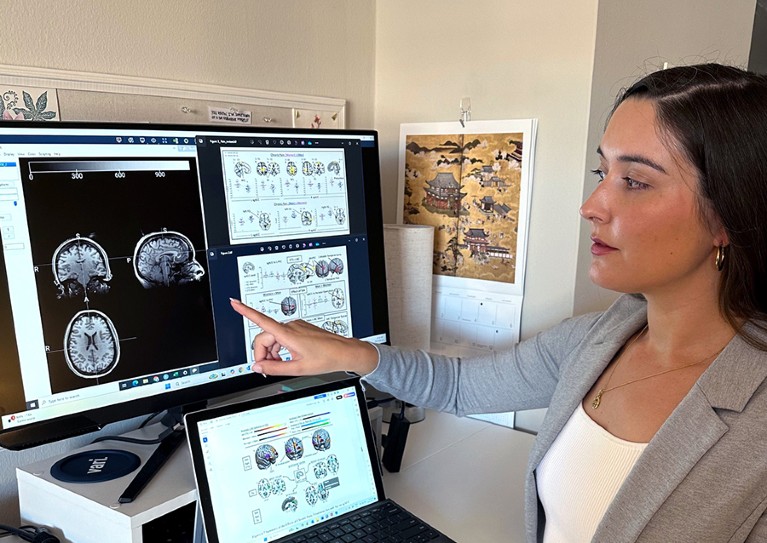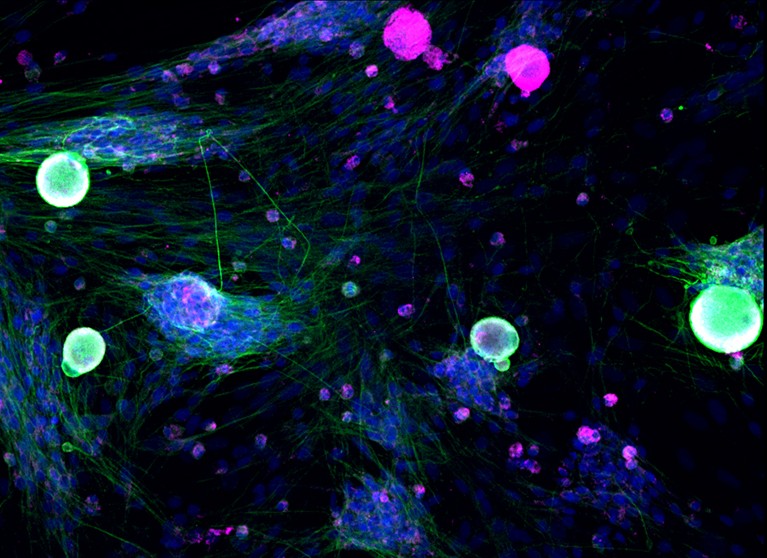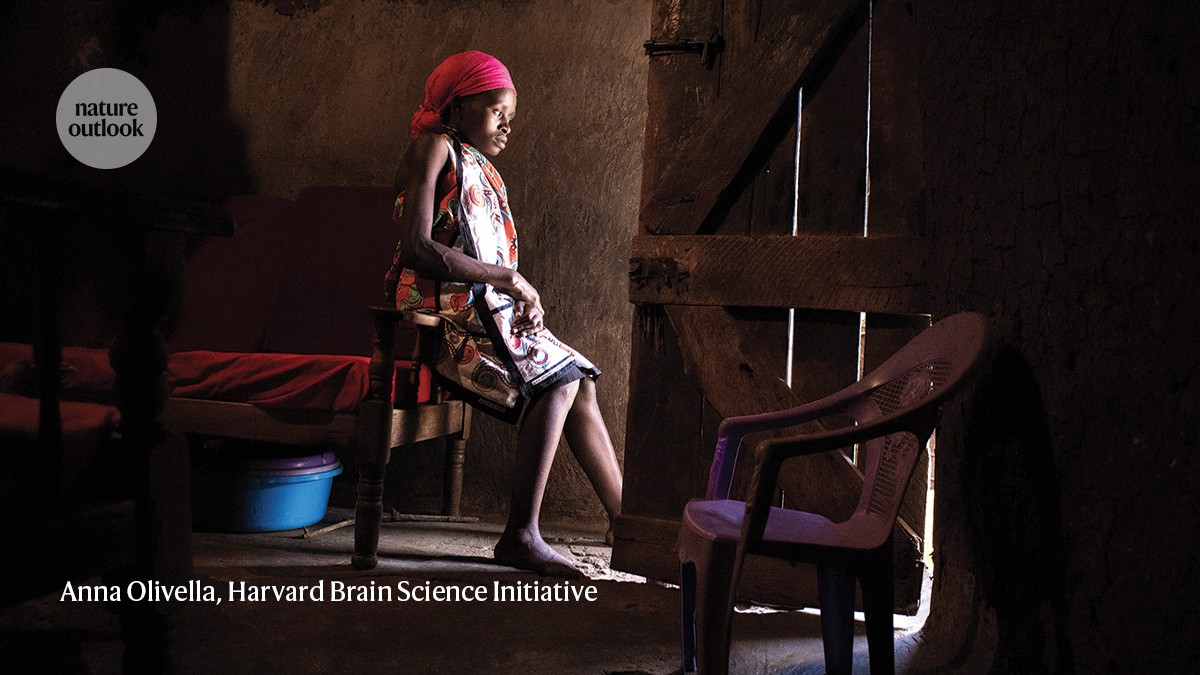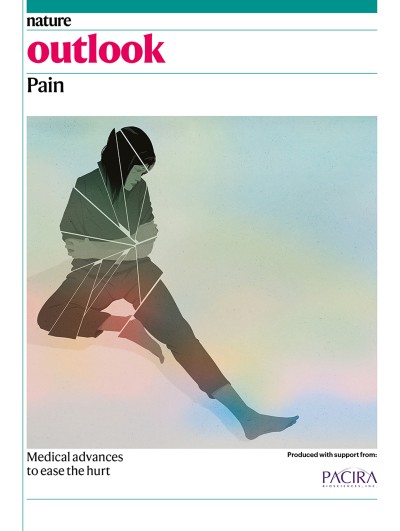“Women are born with pain built in. It’s our physical destiny.” With those words, Kristin Scott Thomas’s character in the TV show Fleabag nailed a truth: that to be female is to be over-represented in statistics about pain.
A study of more than 27,000 people in 19 European countries found that women were 10% more likely than men to report experiencing chronic pain1. Indeed, around half of all chronic pain conditions are more common in women than they are in men; only 20% are more common in men2.
Nature Outlook: Pain
Female animals can also be more sensitive to pain than can males3,4, this is also true in people, and women and girls report higher pain scores when they have the same conditions as their male counterparts. At the same time, women report that their pain is ignored or dismissed by health-care providers5, they wait longer to receive care in emergency settings for acute pain than do men, and are less likely than men to receive any pain relief, including opioids6. The disparity has even prompted a government inquiry in the Australian state of Victoria into medical gender bias and the challenges that women and girls face getting help for pain.
In the laboratory, researchers are working to understand the impact that both sex and gender have on pain, in the hope that finding the answers to these questions could unlock new pain treatments and help to curb the opioid epidemic in some parts of the world. In the clinic, health-care professionals are trying to grapple with a complex and multifactorial condition that can have a devastating impact on women’s lives.
The brain in pain
The impact of sex and gender on the experience of pain first becomes apparent around puberty, says Rui Li, a pain epidemiologist at Seattle Children’s Research Institute in Washington. “There are biological, psychological and social factors that all play a role in explaining this emergence of sex differences in pain,” says Li.
Puberty is a time of major hormonal changes. The hypothalamus in the brain starts producing gonadotropin-releasing hormone, which triggers the testes to produce testosterone and the ovaries to produce oestrogen, both sex hormones.
There is considerable evidence that these fundamental hormonal differences between sexes influence their experience of pain. The impact of testosterone on pain seems straightforward — it is associated with higher thresholds for pain in both people and animals. The impact of oestrogen fluctuations in people with ovaries is more complex, but is associated with changes in the prevalence and intensity of some forms of pain.
Migraine, for example, is three times more likely to affect women than it is men — and episodes often occur within two days of the start of menstruation. The prevalence of migraine in people who have ovaries peaks during reproductive years and generally declines after menopause. Further cementing this link, the use of oestrogen-containing oral contraception can increase both the frequency and severity of migraines.
However, experimental data of pain induced in laboratory settings paints a more complex picture of the effect of oestrogen on the experience of pain. One study in 11 healthy women found that they were more sensitive to thermal pain when their oestrogen levels were higher, but not to the ischaemic pain that comes from performing hand-grip exercises with a tourniquet around the arm7.
Gender-affirming hormone treatment for transgender people sheds further light on the role that sex hormones have in pain. A study8 found that transitioning from male to female was associated with the development of chronic pain during hormone therapy; transitioning from female to male, by contrast, appeared to reduce the impact of existing chronic pain conditions.
Although pain might be felt locally at the site of the threat or injury, it is processed in the brain. And there has long been interest in the neurological mechanisms of pain, and how those mechanisms differ between sexes and genders.
Real-time imaging of people’s brains while they were given painful stimuli suggests that pain is experienced in many parts of the brain, including the insula, the anterior cingulate cortex, the prefrontal cortex, the amygdala and wider somatosensory cortices. Natalie Osborne, a pain neuroscientist at the Gynecology Research Lab at NorthShore University Health System in Evanston, Illinois, is particularly interested in the subgenual anterior cingulate cortex, a region of the brain known to be involved in pain processing and that interacts with other parts of the brain differently in men and women.
Osborne has used functional magnetic resonance imaging to study the subgenual anterior cingulate cortex’s interactions with other pain-sensitive parts of the brain in two chronic pain conditions: ankylosing spondylitis, an inflammatory bone disease which is more common in men; and carpal tunnel syndrome, which is more common in women.

Neuroscientist Natalie Osborne studies a region of the brain that is associated with pain processing.Credit: Kirk Maile
Her research suggests that there is an interaction between sex and chronic pain in this region of the brain, but it’s a perplexing one. Not only did she find differences in subgenual anterior cingulate cortex connectivity between men and women with and without chronic pain conditions, but those sex differences were also influenced by whether the condition was predominantly present in women or in men9. For example, “it seemed like the men with the female-predominant condition had the abnormal subgenual anterior cingulate cortex, not the women; something that to this day I don’t understand”, Osborne says.
Sex, pain and neurochemistry
Sex differences in the perception of pain seem to be hard-wired. Frank Porreca, a pain pharmacologist at the University of Arizona in Tucson, is interested in the neurohormone prolactin. This is produced by the pituitary gland under the control of the hypothalamus, which regulates the stress response.
Given that women have higher stress responses than do men, as well as higher circulating levels of the neurohormone prolactin, Porreca speculated that prolactin might have something to do with their experience of pain. There was also evidence that people with tumours that secrete prolactin have a higher risk of headache and migraine10. “The clinical link was that patients with very high levels of prolactin, both men and women, had an increased frequency of migraine,” Porecca says. This observation led him to conclude that prolactin was influencing the activation of pain receptors.
In one laboratory study11, Porreca and his colleagues looked at how the activity of nociceptors — the nerves that sense pain — were affected by exposure to prolactin. The researchers found that in mice, macaques and humans, prolactin exposure lowered the threshold for activation of those nociceptors, but only in females. They also stumbled on an unexpected second finding: a brain protein called orexin, which has a role in regulating sleep and wakefulness, also sensitized pain receptors, but only in males.
Although the specific influence of sex hormones and sex-specific neurohormones on the physiology and experience of pain is complicated, the findings suggest that pain differences between men and women — particularly in the area of chronic pain — are tied fundamentally to the effects of those hormones. “This means that the system is sexually dimorphic right from the beginning,” says Jeffrey Mogil, a neuroscientist at McGill University in Montreal, Canada. “Nociceptors are the very first link in the chain, and they are already sexually dimorphic.”
Mogil has been interested in sex differences in pain for decades, ever since his accidental discovery as a graduate student that a pain inhibitor worked spectacularly well in male mice but not in female mice. Mogil’s supervisor at the time tried to talk him out of reporting the finding, “because you took a simple thing and it just made it complicated, and we have no explanation for why there should be a sex difference”.
Mogil ignored the advice, and has since gone on to discover more marked differences between male and female animals in the neurobiology of pain. In 2015, he and his colleagues found that what was thought to be an important immune mediator of pain hypersensitivity — microglial cells — was important only in male mice. In female mice, that part was played by T cells12.
The idea that it wasn’t just neurons involved in pain messaging, but also microglial cells, had been viewed as one of the biggest breakthroughs in preclinical pain science, Mogil says. However, he adds, “people were missing huge swaths of the story, by focusing only on male animals and coming to conclusions that they then were happy to generalize to females.”

Prolactin receptors (green) are not present in most male neurons.Credit: Frank Porecca
It’s one of many examples of research that has identified fundamental neurochemical differences in how male and female animals process pain, and underscores the importance of including female mice in animal studies of pain. Since 2014, the US National Institutes of Health have required all federally funded preclinical research — not just pain research — to include both male and female mice or cells, in response to clear bias in favour of using male animals. But it’s not enough just to include them, differences must also be documented.
Earlier this year13, Edmund Keogh, a researcher in the psychology of pain at the University of Bath, UK, and his colleague highlighted the failure of many researchers to disaggregate pain research data by sex or gender. Keogh is hoping to change research reporting practices, suggesting to scientists that even if sex and gender differences aren’t the focus of research, “in your tables just report the data by men and by women,” he says. “Then over time, we can bring lots of studies together and start to see if there is a pattern that emerges.”
The slow pace of change in achieving gender parity in research subjects is partly habit, partly a lack of consideration of the impact of sex and gender and partly not wanting to complicate the research. “Part of it is people staying away because of the expectation that the data you’re going to get from female animals is going to be more variable,” Mogil says. But this is not the case. Although female rodents have fluctuating hormonal cycles, male rodents aren’t exactly a paragon of stability. “Whatever extra variability is going on in males — for example, dominance hierarchies, or when the last time they had a fight in their cage was — that ends up being more variable than the fluctuating female hormones,” Mogil says.
Using female rodents does require some adaptation, says Anna Maria Aloisi, a pain physiologist at the University of Siena in Italy. The oestrus cycle in female rats is four to five days, and in one of her studies Aloisi was looking at a specific point in that cycle. “Every morning, we had to test all females to see which was in that period,” she recalls. But that attention to detail has proved essential, particularly in her study of sex differences in animal reactions to pain. “It was clear that there were many, many sex differences in the behavioural response,” she says. Given how important behavioural responses are in interpreting the effect of pain in animal models, understanding those sex differences is crucial for medical research.
The pain of neglect
Pain is a biological, psychological and social phenomenon, and all three facets have to be considered equally, says Jane Chalmers, a pain researcher and physiotherapist specializing in pelvic pain at the University of South Australia in Adelaide. “One of the hardest things for women with pelvic pain — and women’s pain in general — is more of those sociological factors and the psychological factors,” she says. There is a stigma associated with women’s pain, Chalmers says. “I think women are afraid of being seen as whining or whinging, and we have well-documented experiences of women where they do present to health professionals and their pain is repeatedly dismissed.”
This is especially the case in chronic pelvic pain — an umbrella term for a host of conditions including endometriosis, adenomyosis and prostatitis — which affects an estimated 4–16% of women and 2–10% of men. “There’s a pain clinic in Boston that has simply stated that they won’t see patients with pelvic pain anymore, and of course, that’s primarily women with pain,” says Antje Barreveld, a pain medicine physician at Mass General Brigham in Newton, Massachusetts.
More from Nature Outlooks
Pelvic pain can be challenging to manage in anyone, because sometimes the cause isn’t clear. But women face the added complication of a society that has normalized pain associated with female reproductive organs. “It’s not normal to be basically in a fetal position for four days out a month,” Barreveld says. Many women have internalized this normalization and don’t know that their pain is unusual, she adds. Severe period pain, for example, has a genetic component that can make it a standard experience in a family. “If your sister or your mother also has it, you just think, ‘Okay, well, maybe this is just normal’,” she says.
When women do seek help, many experience long waits to receive it. “We end up seeing these awfully long diagnostic delays,” Chalmers says. In Australia, she says, women typically have symptoms of endometriosis — a condition in which the tissue that lines the uterus grows outside it — for seven or eight years before they’re diagnosed. Chalmers says that delayed diagnoses for women are evident across a range of conditions, including acute ones such as heart attack for which women wait longer for diagnosis and intervention than do men14. They’re also less likely to have post-operative pain treated adequately.
The situation is changing, however. Barreveld says that she is seeing more grant applications, papers and conference presentations about pain in women. And the number of studies that include both male and female animals is increasing, albeit slowly, Mogil says.
Li stresses the need for clinicians to receive more education in pain management, and the potential effects of sex and gender on pain. “Be more creative and more aware of the diversity of human pain experiences there,” she says, “and then try to make people’s pain better.”




